Spatiotemporal Variation Characteristics and Driving Force Analysis of Precipitation Use Efficiency at the North Foot of Yinshan Mountain
Abstract
:1. Introduction
2. Materials and Methods
2.1. Study Area
2.2. Research Methods
2.2.1. Primary Productivity
2.2.2. Precipitation Utilization Efficiency
2.2.3. Trend Analysis
2.2.4. Gray Correlation Analysis
2.2.5. Data Sources
3. Results and Discussion
3.1. Spatiotemporal Characteristics of PUE
3.1.1. Spatial Pattern of NPP and PUE
3.1.2. Interannual Variation of PUE in Grassland
3.1.3. Spatial Variation Trend of PUE in Grassland
3.2. Response of PUE to Climate Factors
3.2.1. Spatial Distribution of Climate Factors
3.2.2. Correlation
3.2.3. Controlling Factors
3.3. The Effect of Terrain on PUE
3.4. Strategies for Improving PUE
3.4.1. Rainwater Harvesting
3.4.2. Drought-Tolerant Grass
- -
- Well-developed roots that can penetrate deep into the soil for efficient water uptake.
- -
- Smaller leaves with reduced surface area to minimize water loss.
- -
- Thick cuticles on leaves with more stomata in epidermal cells regulate stomatal opening and closing in response to arid environments.
- -
- Ability to synthesize and accumulate osmotic regulatory substances like proline and trehalose, which improve cell osmotic potential and maintain cellular hydration.
- -
- Activation of antioxidant enzyme systems that eliminate reactive oxygen species and mitigate oxidative damage caused by drought stress.
3.4.3. Grazing Management
4. Conclusions
- (1)
- NPP and PUE have obvious spatial differentiation at the north foot of Yinshan Mountain. The average NPP and PUE at the northern foot of Yinshan Mountain are 165.16 gC·m−2 and 0.68 gC·m−2·mm−1, respectively. Among the four types of grassland resources, WTS exhibited the highest precipitation use efficiency, while WFT showed the lowest efficiency. Areas with higher PUE values are predominantly located in southern regions such as Wuchuan County, Siziwang Banner, Chahar Right Wing Middle Banner, Taiwusi County, and Duolun County.
- (2)
- From 2001 to 2021, the PUE at the northern foot of Yinshan showed an overall increasing trend. The mean PUE increased from 0.57 to 0.99 gC·m−2·mm−1, with WTS showing a significant increase (almost doubling), which indicated that vegetation restoration had been effectively achieved since the implementation of the project for returning farmland to forest and grassland in 2000.
- (3)
- There is an obvious correlation between PUE and climate factors. Precipitation contributed to a rise in PUE by approximately 19.57%, followed by air temperature (28.33%) and saturated water vapor pressure (27.66%) at the northern foot of Yinshan Mountain during this period. Potential evapotranspiration and wind speed had relatively smaller contributions at around 10.79% and 13.65%, respectively.
Author Contributions
Funding
Data Availability Statement
Conflicts of Interest
References
- Stewart, R.I.A.; Dossena, M.; Bohan, D.A.; Jeppesen, E.; Kordas, R.L.; Ledger, M.E.; Meerhoff, M.; Moss, B.; Mulder, C.; Shurin, J.B.; et al. Mesocosm Experiments as a Tool for Ecological Climate-Change Research. Adv. Ecol. Res. 2013, 48, 71–181. [Google Scholar]
- Wang, L.; Anna, H.; Zhang, L.; Xiao, Y.; Wang, Y.; Xiao, Y.; Liu, J.; Ouyang, Z. Spatial and Temporal Changes of Arable Land Driven by Urbanization and Ecological Restoration in China. Chin. Geogr. Sci. 2019, 29, 809–819. [Google Scholar] [CrossRef]
- Han, Z.; Song, W.; Deng, X.; Xu, X. Grassland Ecosystem Responses to Climate Change and Human Activities within the Three-River Headwaters Region of China. Sci. Rep. 2018, 8, 9079. [Google Scholar] [CrossRef] [PubMed]
- Zeng, X. Water and Nutrient Use Efficiencies of Stipa Purpurea Griseb. along a Precipitation Gradient of the Tibetan Plateau. Plant Soil Environ. 2023, 69, 230–237. [Google Scholar] [CrossRef]
- Ito, A.; Inatomi, M. Water-Use Efficiency of the Terrestrial Biosphere: A Model Analysis Focusing on Interactions between the Global Carbon and Water Cycles. J. Hydrometeorol. 2012, 13, 681–694. [Google Scholar] [CrossRef]
- Yu, H.; Ding, Q.; Meng, B.; Lv, Y.; Liu, C.; Zhang, X.; Sun, Y.; Li, M.; Yi, S. The Relative Contributions of Climate and Grazing on the Dynamics of Grassland NPP and PUE on the Qinghai-Tibet Plateau. Remote Sens. 2021, 13, 3424. [Google Scholar] [CrossRef]
- Zhou, T.; Liu, M.; Sun, J.; Li, Y.; Shi, P.; Tsunekawa, A.; Zhou, H.; Yi, S.; Xue, X. The Patterns and Mechanisms of Precipitation Use Efficiency in Alpine Grasslands on the Tibetan Plateau. Agric. Ecosyst. Environ. 2020, 292, 106833. [Google Scholar] [CrossRef]
- Zhao, Y.; Wang, X.; Vázquez-Jiménez, R. Evaluating the Performance of Remote Sensed Rain-Use Efficiency as an Indicator of Ecosystem Functioning in Semi-Arid Ecosystems. Int. J. Remote Sens. 2018, 39, 3344–3362. [Google Scholar] [CrossRef]
- Mousavi-Baygi, M.; Bannayan, M.; Ashraf, B.; AsadiOskuei, E. Assessment of Climatic Indices Limiting Rainfed Wheat Yield. Ecol. Indic. 2016, 62, 298–305. [Google Scholar] [CrossRef]
- Holzman, M.E.; Carmona, F.; Rivas, R.; Niclòs, R. Early Assessment of Crop Yield from Remotely Sensed Water Stress and Solar Radiation Data. ISPRS J. Photogramm. Remote Sens. 2018, 145, 297–308. [Google Scholar] [CrossRef]
- Liu, X.; Lai, Q.; Yin, S.; Bao, Y.; Qing, S.; Bayarsaikhan, S.; Bu, L.; Mei, L.; Li, Z.; Niu, J.; et al. Exploring Grassland Ecosystem Water Use Efficiency Using Indicators of Precipitation and Soil Moisture across the Mongolian Plateau. Ecol. Indic. 2022, 142, 109207. [Google Scholar] [CrossRef]
- Ren, Z.; Qiao, H.; Xiong, P.; Peng, J.; Wang, B.; Wang, K. Characteristics and Driving Factors of Precipitation-Use Efficiency across Diverse Grasslands in Chinese Loess Plateau. Agronomy 2023, 13, 2296. [Google Scholar] [CrossRef]
- Zhao, J.; Li, J.; Liu, Q.; Xu, B.; Yu, W.; Lin, S.; Hu, Z. Estimating Fractional Vegetation Cover from Leaf Area Index and Clumping Index Based on the Gap Probability Theory. Int. J. Appl. Earth Obs. Geoinf. 2020, 90, 102112. [Google Scholar] [CrossRef]
- Paruelo, J.M.; Lauenroth, W.K.; Burke, I.C.; Sala, O.E. Grassland Precipitation-Use Efficiency Varies Across a Resource Gradient. Ecosystems 1999, 2, 64–68. [Google Scholar] [CrossRef]
- Li, S.; An, P.; Pan, Z.; Wang, F.; Li, X.; Liu, Y. Farmers’ Initiative on Adaptation to Climate Change in the Northern Agro-Pastoral Ecotone. Int. J. Disaster Risk Reduct. 2015, 12, 278–284. [Google Scholar] [CrossRef]
- He, J.; Jiang, X.; Lei, Y.; Cai, W.; Zhang, J. Temporal and Spatial Variation and Driving Forces of Soil Erosion on the Loess Plateau before and after the Implementation of the Grain-for-Green Project: A Case Study in the Yanhe River Basin, China. Int. J. Environ. Res. Public Health 2022, 19, 8446. [Google Scholar] [CrossRef] [PubMed]
- Guo, X.-Y.; Li, J.; Jia, Y.-H.; Yuan, G.-L.; Zheng, J.-L.; Liu, Z.-J. Geochemistry Process from Weathering Rocks to Soils: Perspective of an Ecological Geology Survey in China. Sustainability 2023, 15, 1002. [Google Scholar] [CrossRef]
- Wuyun, D.; Sun, L.; Chen, Z.; Hou, A.; Crusiol, L.G.T.; Yu, L.; Chen, R.; Sun, Z. The Spatiotemporal Change of Cropland and Its Impact on Vegetation Dynamics in the Farming-Pastoral Ecotone of Northern China. Sci. Total Environ. 2022, 805, 150286. [Google Scholar] [CrossRef]
- Wang, S.; Wang, W.; Wu, Y.; Li, W.; Zhao, S.; Chen, Z. Effects of a Changing Climate and Anthropogenic Impacts on Net Primary Production in Yinshanbeilu, Inner Mongolia, China. Environ. Impact Assess. Rev. 2023, 102, 107185. [Google Scholar] [CrossRef]
- Wu, C.; Chen, K.; Chongyi, E.; You, X.; He, D.; Hu, L.; Liu, B.; Wang, R.; Shi, Y.; Li, C.; et al. Improved CASA Model Based on Satellite Remote Sensing Data: Simulating Net Primary Productivity of Qinghai Lake Basin Alpine Grassland. Geosci. Model Dev. 2022, 15, 6919–6933. [Google Scholar] [CrossRef]
- Jiang, T.; Wang, X.; Afzal, M.M.; Sun, L.; Luo, Y. Vegetation Productivity and Precipitation Use Efficiency across the Yellow River Basin: Spatial Patterns and Controls. Remote Sens. 2022, 14, 5074. [Google Scholar] [CrossRef]
- Zhou, J.; Deitch, M.J.; Grunwald, S.; Screaton, E. Do the Mann-Kendall Test and Theil-Sen Slope Fail to Inform Trend Significance and Magnitude in Hydrology? Hydrol. Sci. J. 2023, 68, 1241–1249. [Google Scholar] [CrossRef]
- Sun, Y.; Liu, S.; Li, L. Grey Correlation Analysis of Transportation Carbon Emissions under the Background of Carbon Peak and Carbon Neutrality. Energies 2022, 15, 3064. [Google Scholar] [CrossRef]
- Mu, S.; You, Y.; Zhu, C.; Zhou, K. Spatio-Temporal Patterns of Precipitation-Use Efficiency of Grassland in Northwestern China. Acta Ecol. Sin. 2017, 37, 1458–1471. [Google Scholar]
- Zhang, X.; Susan Moran, M.; Zhao, X.; Liu, S.; Zhou, T.; Ponce-Campos, G.E.; Liu, F. Impact of Prolonged Drought on Rainfall Use Efficiency Using MODIS Data across China in the Early 21st Century. Remote Sens. Environ. 2014, 150, 188–197. [Google Scholar] [CrossRef]
- Yang, Y.; Fang, J.; Fay, P.A.; Bell, J.E.; Ji, C. Rain Use Efficiency across a Precipitation Gradient on the Tibetan Plateau. Geophys. Res. Lett. 2010, 37, L15702. [Google Scholar] [CrossRef]
- Lauenroth, W.K.; Burke, I.C.; Paruelo, J.M. Patterns of Production and Precipitation-Use Efficiency of Winter Wheat and Native Grasslands in the Central Great Plains of the United States. Ecosystems 2000, 3, 344–351. [Google Scholar] [CrossRef]
- Bai, Y.; Wu, J.; Xing, Q.; Pan, Q.; Huang, J.; Yang, D.; Han, X. Primary Production and Rain Use Efficiency across a Precipitation Gradient on the Mongolia Plateau. Ecology 2008, 89, 2140–2153. [Google Scholar] [CrossRef] [PubMed]
- Hua, Y.; Ma, X.; Siqin, B. Spatial and Temporal Characteristics of Precipitation Utilization Efficiency of Desert Steppe Vegetation in Inner Mongolia. J. Desert Res. 2021, 41, 51–58. [Google Scholar]
- Ye, H.; Wang, J.; Huang, M.; Qi, S. Spatial Pattern of Vegetation Precipitation Use Efficiency and Its Response to Precipitation and Temperature on the Qinghai-Xizang Plateau of China. Chin. J. Plant Ecol. 2012, 36, 1237–1247. [Google Scholar] [CrossRef]
- Han, D.; Zhang, F.; Chen, J.; Li, Y.; Lu, Q. Characteristics of Grassland Evapotranspiration in Semi-Arid Area and Its Responses to Meteorological Factors and Vegetation. Acta Agrestia Sin. 2021, 29, 166–173. [Google Scholar]
- Du, X.; Zhao, X.; Wang, H.; He, B. Responses of Terrestrial Ecosystem Water Use Efficiency to Climate Change: A Review. Acta Ecol. Sin. 2018, 38, 8296–8305. [Google Scholar]
- Wang, Y.; Lv, W.; Xue, K.; Wang, S.; Zhang, L.; Hu, R.; Zeng, H.; Xu, X.; Li, Y.; Jiang, L.; et al. Grassland Changes and Adaptive Management on the Qinghai–Tibetan Plateau. Nat. Rev. Earth Environ. 2022, 3, 668–683. [Google Scholar] [CrossRef]


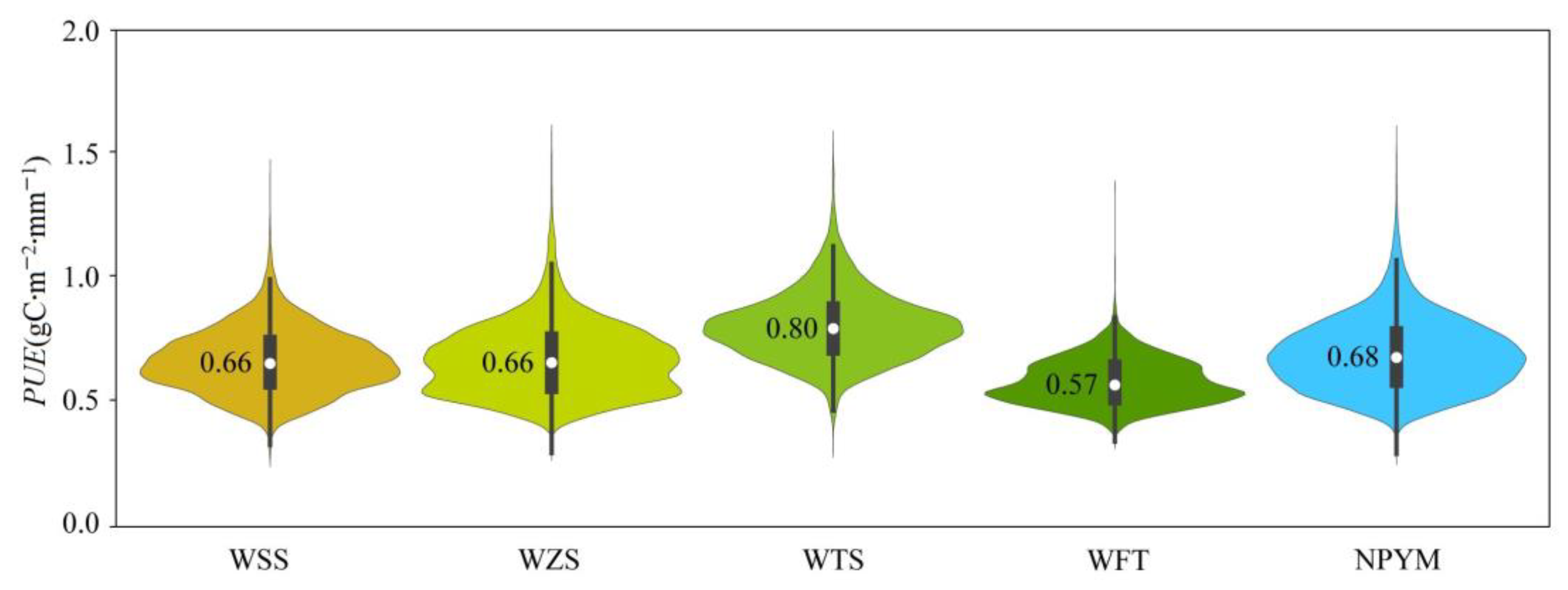
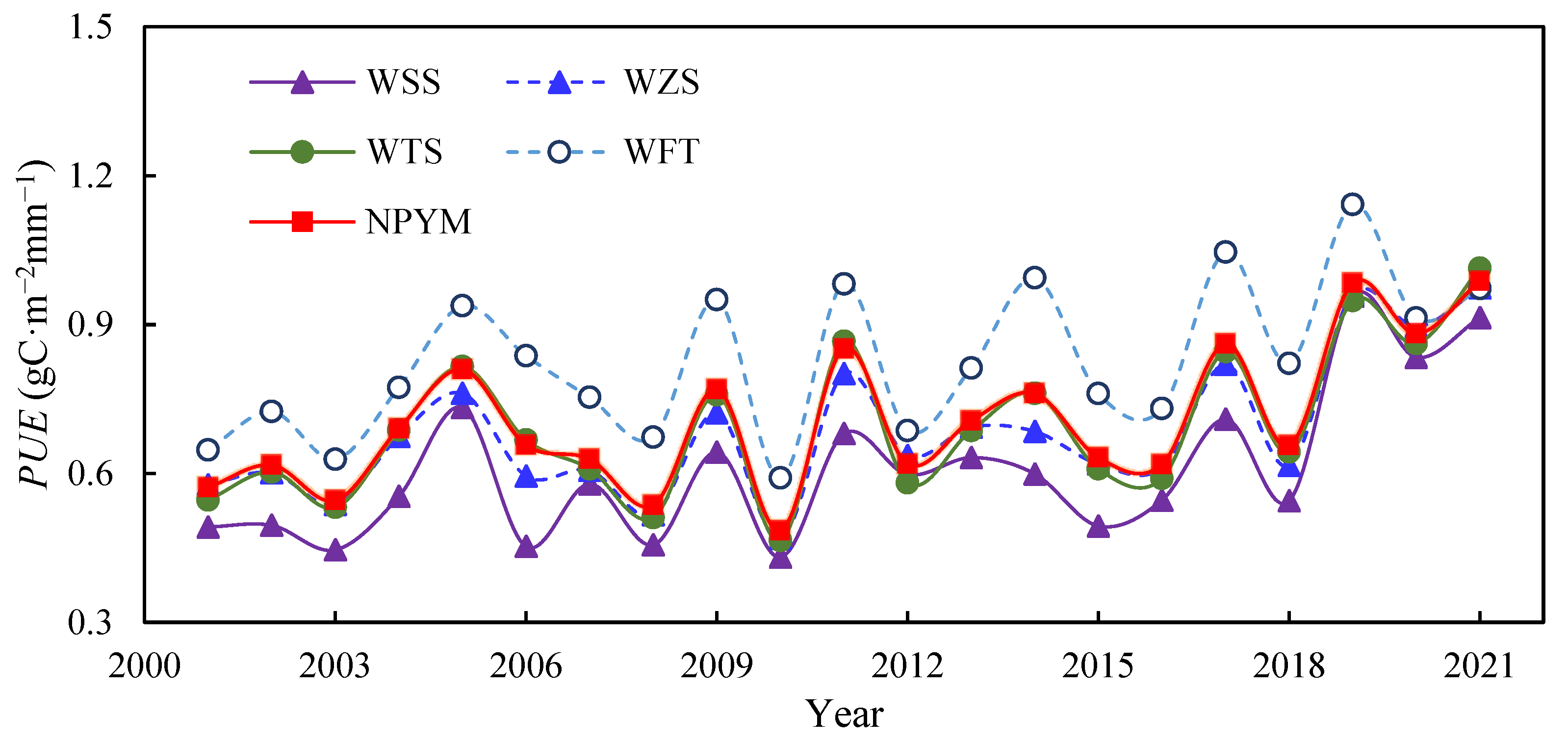


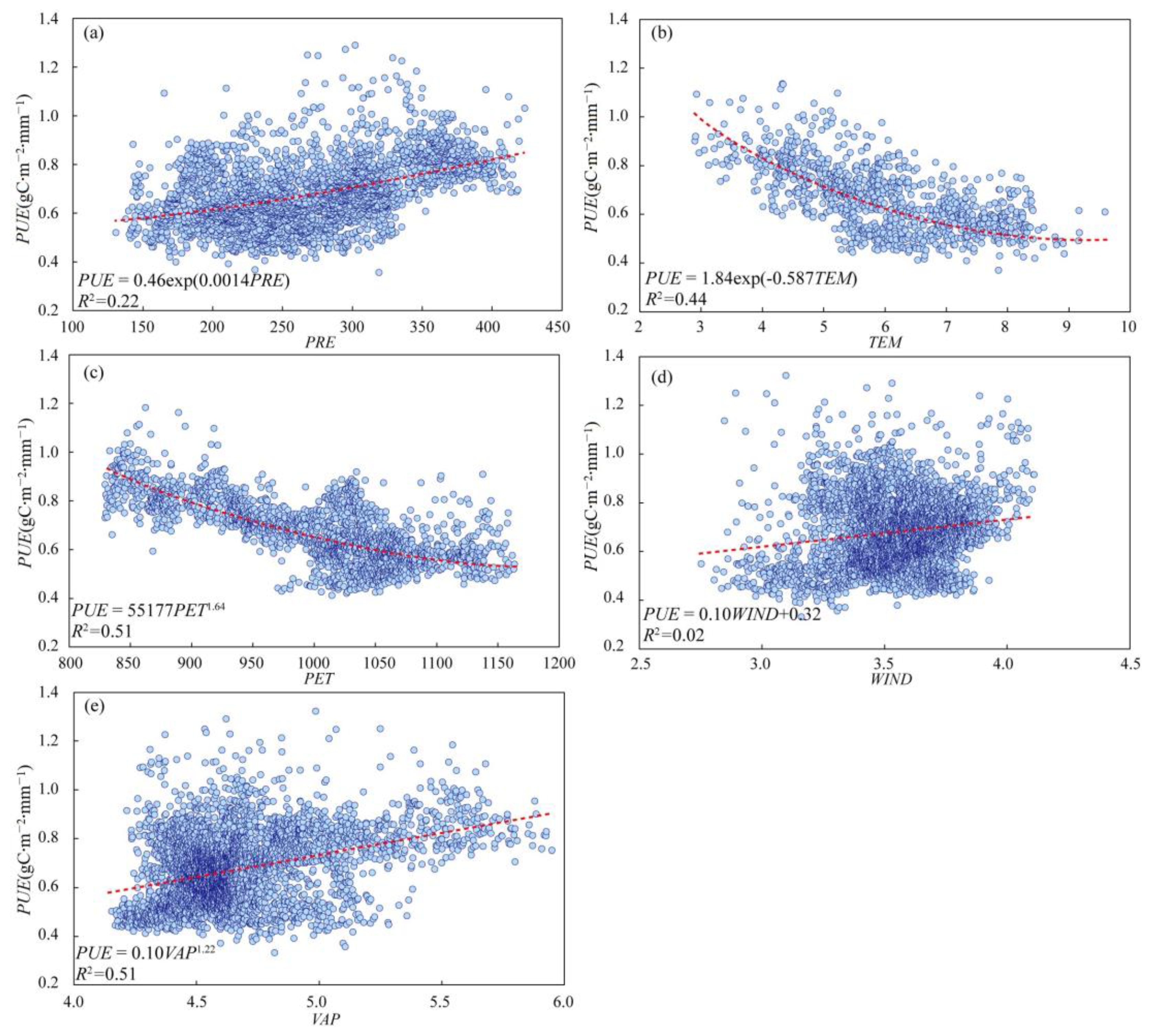
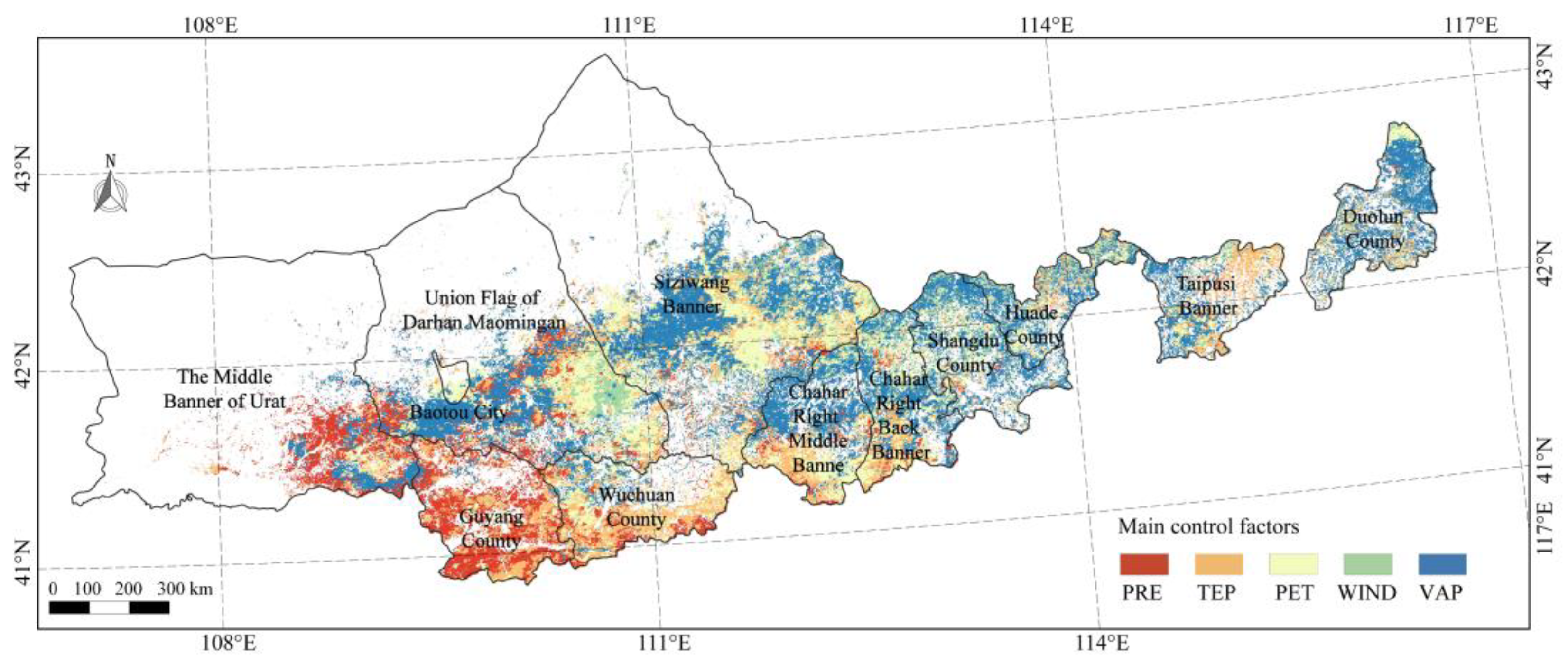
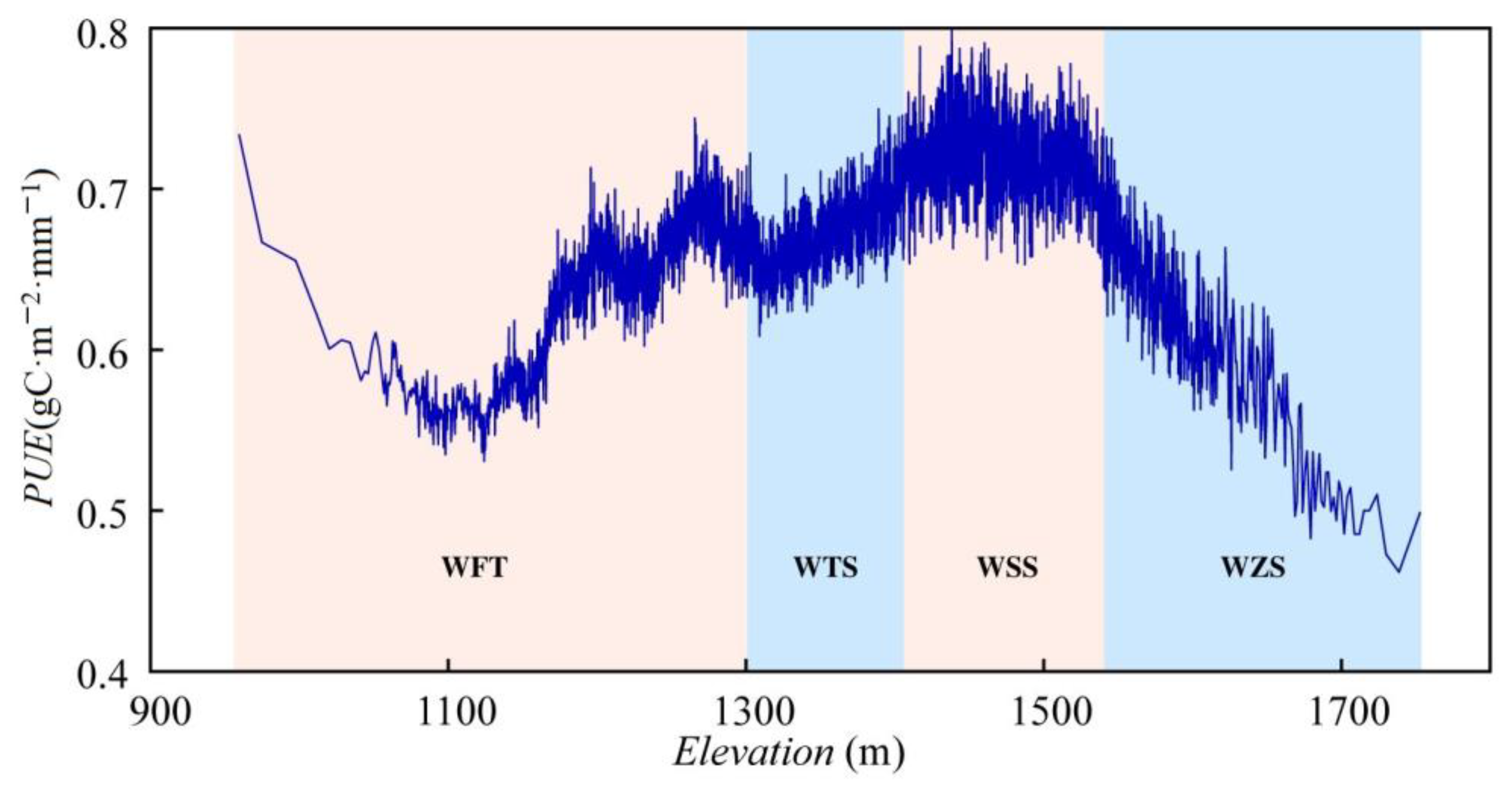
| Data Type | Dataset | Provider |
|---|---|---|
| NDVI | MOD13Q1 | Google Earth Engine by NASA LP DAAC at the GSGS EROS Center |
| Meteorological | Temperature | China Meteorological Data Service Center |
| Land cover | GlobeLand30 | China National Geomatics Center |
Disclaimer/Publisher’s Note: The statements, opinions and data contained in all publications are solely those of the individual author(s) and contributor(s) and not of MDPI and/or the editor(s). MDPI and/or the editor(s) disclaim responsibility for any injury to people or property resulting from any ideas, methods, instructions or products referred to in the content. |
© 2023 by the authors. Licensee MDPI, Basel, Switzerland. This article is an open access article distributed under the terms and conditions of the Creative Commons Attribution (CC BY) license (https://creativecommons.org/licenses/by/4.0/).
Share and Cite
Yang, Y.; Liu, H.; Tao, W.; Shan, Y. Spatiotemporal Variation Characteristics and Driving Force Analysis of Precipitation Use Efficiency at the North Foot of Yinshan Mountain. Water 2024, 16, 99. https://doi.org/10.3390/w16010099
Yang Y, Liu H, Tao W, Shan Y. Spatiotemporal Variation Characteristics and Driving Force Analysis of Precipitation Use Efficiency at the North Foot of Yinshan Mountain. Water. 2024; 16(1):99. https://doi.org/10.3390/w16010099
Chicago/Turabian StyleYang, Yi, Hu Liu, Wanghai Tao, and Yuyang Shan. 2024. "Spatiotemporal Variation Characteristics and Driving Force Analysis of Precipitation Use Efficiency at the North Foot of Yinshan Mountain" Water 16, no. 1: 99. https://doi.org/10.3390/w16010099




